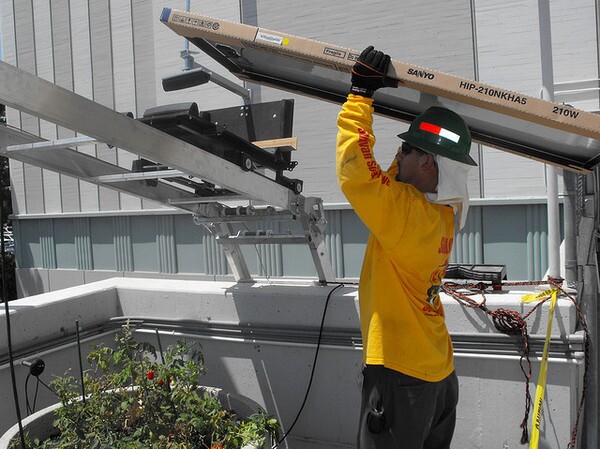Corporate or Community Energy? San Diegans May Get to Choose

Installing solar panels at the Port of San Diego | Photo: Port of San Diego/Flickr/Creative Commons License
If a San Diego non-profit has its way, California's third-largest city may soon offer its residents an alternative to San Diego Gas & Electric (SDG&E) when they buy their electrical power. The San Diego Energy District Foundation, formed last year, is working to launch a Community Choice Aggregation program, which would provide San Diegans with a non-profit way to buy renewable energy without even flipping a switch.
Community Choice Aggregation (CCA), a concept enacted in California law in 2002 in the wake of the California electricity crisis, allows cities, counties, or groups thereof to buy electricity for their residents and businesses. A CCA differs from a municipal utility in that municipal utilities generally own their electrical distribution network and even some power generation capacity: a CCA may merely buy electricity wholesale to distribute among its customers.
Related

What Are? PACE Loans, Feed In Tariffs and Net Metering

What is...? The Grid
A CCA offers several potential benefits over an investor-owned utility. Removing the need for financial return to shareholders means power prices can be significantly lower, and CCAs can decide to experiment with renewable energy incentives such as feed-in tariffs. San Diego's CCA backers pledge to far exceed California's Renewable Portfolio Standards requirement that utilities serve up renewable electricity as 33% of their total power delivered. And the San Diego CCA got a boost in motivation last year, when SDG&E attempted to charge rooftop solar panel owners for "grid access." (The utility dropped that proposal quickly, but continues to attempt to have penalties for distributed generation enshrined in California law.) "CCA is an off-the-shelf alternative to the status quo, which creates a structure open to innovation and local involvement in electricity generation," says SDED Foundation co-founder Bill Powers, an engineer and utility consultant.
San Diego joins a number of other California municipalities and counties in considering a CCA. At present, Marin County has the only CCA in California that is currently delivering power, but a pending CCA in the San Joaquin Valley has won California Public Utilities Commission approval for its implementation plan. Groups in San Francisco, Los Angeles, Oakland and a few neighboring cities, and Sonoma County are all considering CCAs. The city council of Richmond, across the San Francisco Bay from Marin County, voted last month to join Marin's CCA.
The law survived an attempted revision in 2010: Proposition 16, sponsored by PG&E, would have required any district considering a CCA to gain approval from two-thirds of its voters. Though PG&E spent heavily in support of the proposition, it failed at the polls. Nonetheless, the ballot measure was a setback for California CCAs, as several of the CCA projects mentioned above were put on hold pending the election.
Economic considerations helped delay older CCA proposals in California, as proponents discovered in 2005 and thereabouts that they couldn't guarantee lower electric prices than their corporate competition. But a combination of plummeting photovoltaic costs and cheap natural gas as a result of fracking have made it far easier to compete with utilities in the retail market. Marin may not be the only fully functional CCA for very long.
ReWire is dedicated to covering renewable energy in California. Keep in touch by liking us on Facebook, and help shape our editorial direction by taking this quick survey here.


